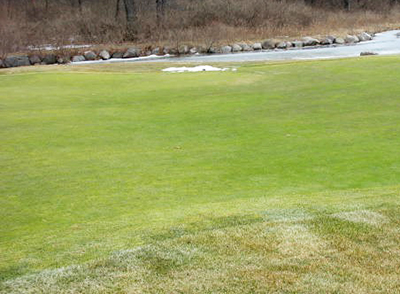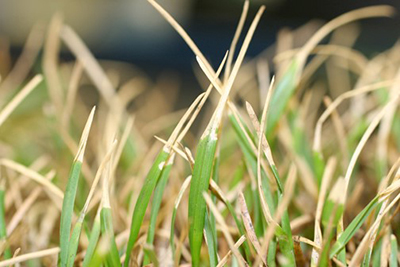Poa annua putting greens declining?
Poa annua putting greens have been showing signs of stress in the last week that may be related to winterkill.

In the last couple days I’ve received reports from several golf course superintendents indicating that Poa annua on putting greens that emerged from winter looking good are now declining. It is possible that this is winterkill to the lower region of the crown that is responsible for root initiation.
For those of you that have James B. Beard’s seminal textbook, “Turfgrass: Science and Culture,” on the shelf, turn to page 235. In the text, Beard writes about differential low temperature tolerance between the upper portion of the Poa annua crown, responsible for new leaf initiation, and the lower portion of the crown, responsible for root initiation. The upper portion of the crown has higher low temperature hardiness, meanting it can survive at lower temperatures.

Poa annua on same putting green as first picture emerging from winter looking fine. Picture taken March 16, 2015. Photo credit: Kevin Frank, MSU
Back in 2003, Beard taught the turfgrass physiology class at Michigan State University and I was fortunate to attend many of his lectures. I recall Beard describing a scenario in Detroit one spring when Poa annua emerged from winter looking just fine and in the matter of a couple days when the temperatures warmed, everything died. He indicated this was the result of the lower crown suffering winterkill and although many thought the Poa annua was just dying over the weekend, it was in fact already dead. Without the ability to grow roots, the Poa annua didn’t survive long once the plant started “demanding” water. Take a look at the crown; if it's white and firm, all is well, and if it's brown and mush, it's dead.
I’m not certain this is what happened this year or if it’s typical freezing injury that is the result of cold night temperatures. Freezing injury is typical this time of year and is especially evident on lawn height Kentucky bluegrass where the symptoms are tanning of the leaf blade down from the tip. Warm temperatures and rainfall in the forecast should reveal whether or not what is being reported is indeed winterkill or, hopefully, something less significant.

Leaf tip freeze injury. Photo credit: Kevin Frank, MSU
Dr. Frank’s work is funded in part by MSU’s AgBioResearch.



 Print
Print Email
Email


